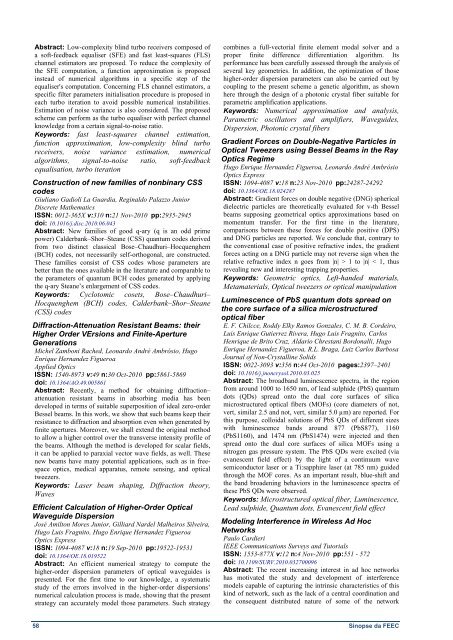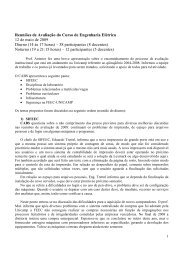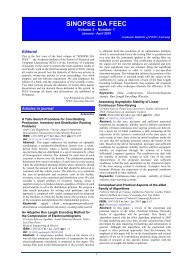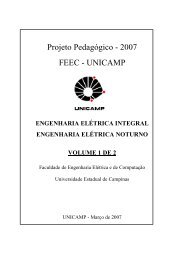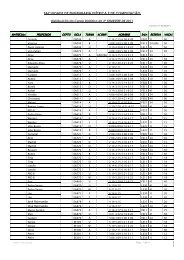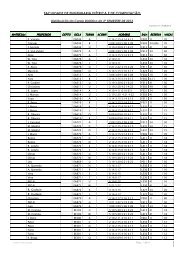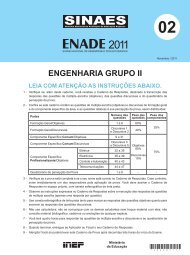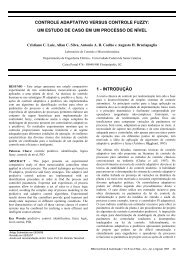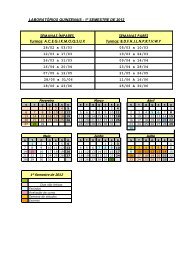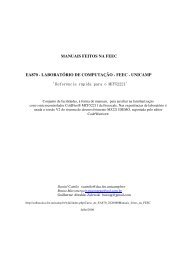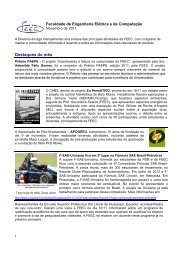sinopseV3n3.pdf - FEEC - Unicamp
sinopseV3n3.pdf - FEEC - Unicamp
sinopseV3n3.pdf - FEEC - Unicamp
Create successful ePaper yourself
Turn your PDF publications into a flip-book with our unique Google optimized e-Paper software.
Abstract: Low-complexity blind turbo receivers composed of<br />
a soft-feedback equaliser (SFE) and fast least-squares (FLS)<br />
channel estimators are proposed. To reduce the complexity of<br />
the SFE computation, a function approximation is proposed<br />
instead of numerical algorithms in a specific step of the<br />
equaliser's computation. Concerning FLS channel estimators, a<br />
specific filter parameters initialisation procedure is proposed in<br />
each turbo iteration to avoid possible numerical instabilities.<br />
Estimation of noise variance is also considered. The proposed<br />
scheme can perform as the turbo equaliser with perfect channel<br />
knowledge from a certain signal-to-noise ratio.<br />
Keywords: fast least-squares channel estimation,<br />
function approximation, low-complexity blind turbo<br />
receivers, noise variance estimation, numerical<br />
algorithms, signal-to-noise ratio, soft-feedback<br />
equalisation, turbo iteration<br />
Construction of new families of nonbinary CSS<br />
codes<br />
Giuliano Gadioli La Guardia, Reginaldo Palazzo Junior<br />
Discrete Mathematics<br />
ISSN: 0012-365X v:310 n:21 Nov-2010 pp:2935-2945<br />
doi: 10.1016/j.disc.2010.06.043<br />
Abstract: New families of good q-ary (q is an odd prime<br />
power) Calderbank–Shor–Steane (CSS) quantum codes derived<br />
from two distinct classical Bose–Chaudhuri–Hocquenghem<br />
(BCH) codes, not necessarily self-orthogonal, are constructed.<br />
These families consist of CSS codes whose parameters are<br />
better than the ones available in the literature and comparable to<br />
the parameters of quantum BCH codes generated by applying<br />
the q-ary Steane’s enlargement of CSS codes.<br />
Keywords: Cyclotomic cosets, Bose–Chaudhuri–<br />
Hocquenghem (BCH) codes, Calderbank–Shor–Steane<br />
(CSS) codes<br />
Diffraction-Attenuation Resistant Beams: their<br />
Higher Order VErsions and Finite-Aperture<br />
Generations<br />
Michel Zamboni Rached, Leonardo André Ambrósio, Hugo<br />
Enrique Hernandez Figueroa<br />
Applied Optics<br />
ISSN: 1540-8973 v:49 n:30 Oct-2010 pp:5861-5869<br />
doi: 10.1364/AO.49.005861<br />
Abstract: Recently, a method for obtaining diffraction–<br />
attenuation resistant beams in absorbing media has been<br />
developed in terms of suitable superposition of ideal zero-order<br />
Bessel beams. In this work, we show that such beams keep their<br />
resistance to diffraction and absorption even when generated by<br />
finite apertures. Moreover, we shall extend the original method<br />
to allow a higher control over the transverse intensity profile of<br />
the beams. Although the method is developed for scalar fields,<br />
it can be applied to paraxial vector wave fields, as well. These<br />
new beams have many potential applications, such as in freespace<br />
optics, medical apparatus, remote sensing, and optical<br />
tweezers.<br />
Keywords: Laser beam shaping, Diffraction theory,<br />
Waves<br />
Efficient Calculation of Higher-Order Optical<br />
Waveguide Dispersion<br />
José Amilton Mores Junior, Gilliard Nardel Malheiros Silveira,<br />
Hugo Luis Fragnito, Hugo Enrique Hernandez Figueroa<br />
Optics Express<br />
ISSN: 1094-4087 v:18 n:19 Sep-2010 pp:19522-19531<br />
doi: 10.1364/OE.18.019522<br />
Abstract: An efficient numerical strategy to compute the<br />
higher-order dispersion parameters of optical waveguides is<br />
presented. For the first time to our knowledge, a systematic<br />
study of the errors involved in the higher-order dispersions’<br />
numerical calculation process is made, showing that the present<br />
strategy can accurately model those parameters. Such strategy<br />
combines a full-vectorial finite element modal solver and a<br />
proper finite difference differentiation algorithm. Its<br />
performance has been carefully assessed through the analysis of<br />
several key geometries. In addition, the optimization of those<br />
higher-order dispersion parameters can also be carried out by<br />
coupling to the present scheme a genetic algorithm, as shown<br />
here through the design of a photonic crystal fiber suitable for<br />
parametric amplification applications.<br />
Keywords: Numerical approximation and analysis,<br />
Parametric oscillators and amplifiers, Waveguides,<br />
Dispersion, Photonic crystal fibers<br />
Gradient Forces on Double-Negative Particles in<br />
Optical Tweezers using Bessel Beams in the Ray<br />
Optics Regime<br />
Hugo Enrique Hernandez Figueroa, Leonardo André Ambrósio<br />
Optics Express<br />
ISSN: 1094-4087 v:18 n:23 Nov-2010 pp:24287-24292<br />
doi: 10.1364/OE.18.024287<br />
Abstract: Gradient forces on double negative (DNG) spherical<br />
dielectric particles are theoretically evaluated for v-th Bessel<br />
beams supposing geometrical optics approximations based on<br />
momentum transfer. For the first time in the literature,<br />
comparisons between these forces for double positive (DPS)<br />
and DNG particles are reported. We conclude that, contrary to<br />
the conventional case of positive refractive index, the gradient<br />
forces acting on a DNG particle may not reverse sign when the<br />
relative refractive index n goes from |n| > 1 to |n| < 1, thus<br />
revealing new and interesting trapping properties.<br />
Keywords: Geometric optics, Left-handed materials,<br />
Metamaterials, Optical tweezers or optical manipulation<br />
Luminescence of PbS quantum dots spread on<br />
the core surface of a silica microstructured<br />
optical fiber<br />
E. F. Chilcce, Roddy Elky Ramos Gonzales, C. M. B. Cordeiro,<br />
Luis Enrique Gutierrez Rivera, Hugo Luis Fragnito, Carlos<br />
Henrique de Brito Cruz, Aldario Chrestani Bordonalli, Hugo<br />
Enrique Hernandez Figueroa, R.L. Braga, Luiz Carlos Barbosa<br />
Journal of Non-Crystalline Solids<br />
ISSN: 0022-3093 v:356 n:44 Oct-2010 pages:2397–2401<br />
doi: 10.1016/j.jnoncrysol.2010.03.025<br />
Abstract: The broadband luminescence spectra, in the region<br />
from around 1000 to 1650 nm, of lead sulphide (PbS) quantum<br />
dots (QDs) spread onto the dual core surfaces of silica<br />
microstructured optical fibers (MOFs) (core diameters of not,<br />
vert, similar 2.5 and not, vert, similar 5.0 µm) are reported. For<br />
this purpose, colloidal solutions of PbS QDs of different sizes<br />
with luminescence bands around 877 (PbS877), 1160<br />
(PbS1160), and 1474 nm (PbS1474) were injected and then<br />
spread onto the dual core surfaces of silica MOFs using a<br />
nitrogen gas pressure system. The PbS QDs were excited (via<br />
evanescent field effect) by the light of a continuum wave<br />
semiconductor laser or a Ti:sapphire laser (at 785 nm) guided<br />
through the MOF cores. As an important result, blue-shift and<br />
the band broadening behaviors in the luminescence spectra of<br />
these PbS QDs were observed.<br />
Keywords: Microstructured optical fiber, Luminescence,<br />
Lead sulphide, Quantum dots, Evanescent field effect<br />
Modeling Interference in Wireless Ad Hoc<br />
Networks<br />
Paulo Cardieri<br />
IEEE Communications Surveys and Tutorials<br />
ISSN: 1553-877X v:12 n:4 Nov-2010 pp:551 - 572<br />
doi: 10.1109/SURV.2010.032700096<br />
Abstract: The recent increasing interest in ad hoc networks<br />
has motivated the study and development of interference<br />
models capable of capturing the intrinsic characteristics of this<br />
kind of network, such as the lack of a central coordination and<br />
the consequent distributed nature of some of the network<br />
58 Sinopse da <strong>FEEC</strong>


